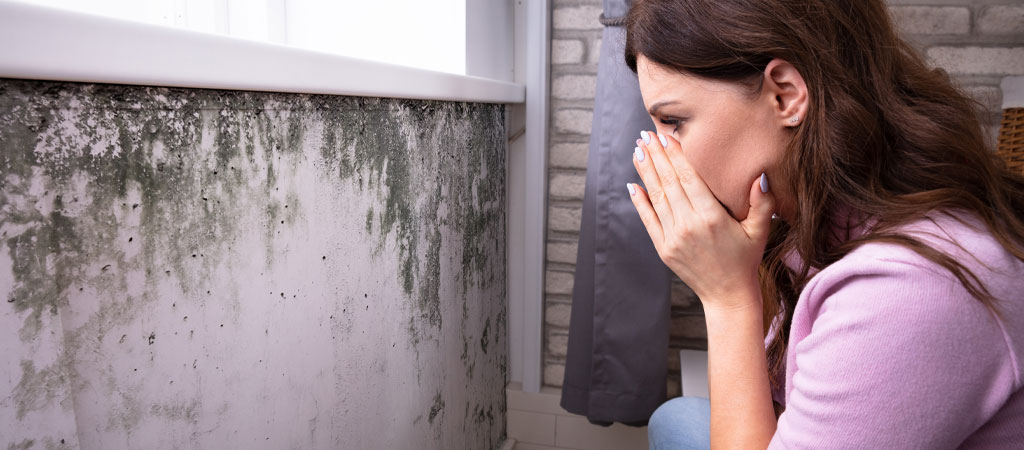
How fast does mold grow after a water leak?
Mold thrives anywhere there is a moist environment. If your home has suffered water damage due to monsoon flooding, sewage back-up, plumbing or roof leaks, or bathtub and/or sink overflows, mold can develop within 24-48 hours of water exposure. The mold will continue to grow until the source of moisture is removed and timely drying begins.
In addition to the damage molds can cause in your home, all molds are capable of adversely affecting human health.
Mistakes to avoid during mold remediation

Be sure to avoid the following mistakes:
- Bleach does not kill mold. Cleaning mold with bleach is not going to help.
- Mold containment is essential. Scrubbing mold will cause mold spores to become airborne and expose your entire home.
- Throw away all cleaning materials and clothing you used to prevent mold contamination.
- Eliminate the moisture source. Mold will keep coming back until you fix the moisture problems.
Mold containment of the affected area
Mold containment is the most important step in the mold remediation process. The infected area has to be isolated from rest of the house. Containment ensures that mold in the area being remediated does not spread into other areas of the home when it becomes airborne. And it WILL become airborne.
Mold Containment Step 1
Install physical barriers around the infected area. You will need heavy duty plastic (yard trash bags can work) and duct tape. The main goal for the barrier is to completely contain the infected area from any non-affected areas of the home.
Mold Containment Step 2
Cover ALL openings inside the barrier need to be taped or covered in plastic. This may include:
- Windows
- Doorways
- Hallway entrances
- Air vents
- Drains
- Ducts
- Skylights
- Electrical outlets
- Light fixtures
- Exhaust fans
Mold removal
While Commercial Cleaning and Restoration does not recommend DIY mold removal, we know that there are a lot of people out there who do NOT properly contain the infected area. Many DIY have found that they didn’t have the right safety equipment or they found a larger issue than they expected.
Mold Removal Step 1
The containment area needs to have enough space to work INSIDE including bagged materials you are removing and HEPA air filter. Don’t make the area too big but you also don’t want the space too small to work. Install tape on each side of the plastic for entrance/exit so you can enter and exit the containment barrier easily.
Mold Removal Step 2
To haul the moldy materials outdoors you need to create a path all the way from the containment area to outside.
Mold Removal Step 3
Install a HEPA filtered negative air machine in the contained area. This fan will pull air from the affected area and via flexible tubing will expel the contaminated air outside. If the containment is working when you turn on the negative air machine, the plastic sheeting should billow inwards. If it flutters outward, containment has been lost, and you should find and correct the problem.
Mold Removal Step 4
Before you remove the moldy materials, outfit yourself with personal protective equipment. You will need gloves, googles, a respirator, and disposable clothing.
Air Quality Testing
If you have a breach in your containment area, it’s time for air quality testing. In most cases, our turn-around time is 48 hours. We don’t have to wait long for sample test results because all our testing is done locally with our partner, Dr. Mark Sneller of Aero-Allergen Research.
The potential for health problems occurs when people inhale the airborne mold spores. Typical symptoms reported from mold exposure include:
- Respiratory problems – wheezing, asthma attacks, etc
- Nasal and sinus congestion or dry, hacking cough
- Eye irritation – burning, watery, redness
- Nose or throat irritation – sneezing fits, bloody noses
- Skin irritations – rashes or hives
- Nervous system – headaches, memory loss, mood changes
- Aches and pains

Can mold affect your house value?
There’s no question that part of maintaining a healthy home involves mold prevention and quick mold remediation. The longer mold is allowed to thrive and colonize, the more difficult it will be to remove the infestation completely.
Does mold really affect your home’s value that much? The answer is yes. According to researchers who conducted a detailed study in 2001, researchers found that 25% losses in value were common as a result of large scale mold infestation.
There’s only one logical conclusion: It should be removed by a mold remediation professional before the problem grows larger. Once mold has been located, removed properly, a clearance test (air sampling) should be done. Mold is visible when colonizing, however the spores are so small you can not rely on your eye that all the mold has been dealt with properly.. A clearance test is done exactly like the initial test and will be a documented evidence that the mold issue has been properly removed when the test comes back clear.
Once the remediation is complete and your insurance company has sent you the restoration funds, we suggest ordering materials. Be prepared for a process. The repair stage has a lot of moving parts – Commercial Cleaning and Restoration’s scope of work; materials must be ordered and received; a specialty contractor may be needed for an upgrade; etc. Be patient and stay focused on a beautiful outcome!
Carpet • Tile • Area Rugs • Upholstered Furniture
If you are interested in having your flooring and upholstery professionally cleaned, schedule an appointment at (520) 297-4736 for your home today!

